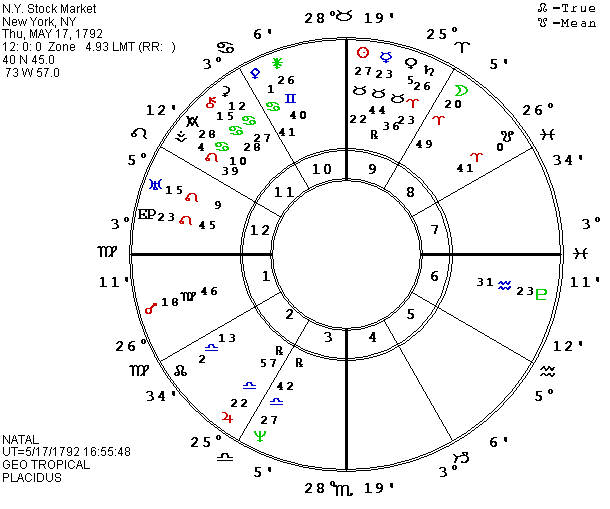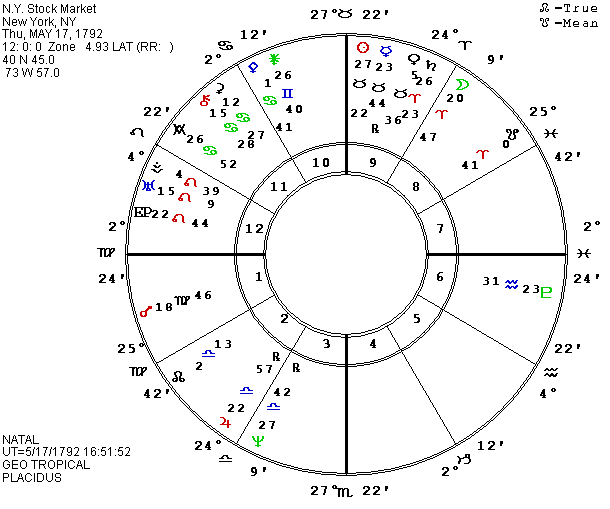Not the Stock Market Again!
Zip Dobyns
I should have waited one more issue of The Mutable Dilemma to include the market chart, though by writing in early June I can again claim accuracy in predicting the upturn in the market in the last half of the year. It started doing its “thing” in late July.
The reason for this new look at the market, at the risk of boring our readers who are not into the financial scene, is information gained at the AFA conference in Chicago in late July. One of the panels produced by ACT which is held under the sponsorship of the AFA, involved several individuals who invest and/or advise others with the aid of astrology. I can’t remember when I have seen such unanimity among astrologers as they had in predicting the coming of a major depression. Since I have been saying for two and a half years that the patterns in the U.S. charts from late 1986 through 1988 were uncomfortably similar to patterns in 1929, I had mixed feelings about so much agreement. I would rather be wrong in my judgment than to wish such misery on the world. But if the judgment is right, at least we can get our own life prepared. I still think that modern technology will eventually pull us out of the pressure period, and that people providing necessities and well-managed companies involved in new technology, will ride it through. But we do have to learn to share the earth. At present, the owners of the successful high tech businesses stand to profit enormously but many people who lack education and specialized skills are in increasing trouble.
Though I found the panel on the market interesting and perhaps a bit scary in the negative forecasts, the jewel of the session was provided by a man in the audience at the end of the panel. I don’t even know his name or home, but would like to express my gratitude for a piece of information I had been seeking for years. In commenting on his dismay at the number of inaccurate charts used by astrologers, he used the chart of the N.Y. stock exchange as an example. He said he had seen charts with many different times (which I knew, having experimented with them from 8:15 to 11:15 A.M.), and he added firmly that according to the record, the Exchange was started at “high noon.” Ring the bells, hit the gong, and glory hallelujah, if we really have a record of the time.


I am now in the process of working with progressed charts for every past panic which I have been able to cull from my sources. In my usual state of time-bind, the job is not likely to be finished until next winter. Especially since I will be on the road most of the time to mid-November. But initial efforts look promising. We do have a question whether “high noon” means the time on a sundial (meaning Sun exactly on the MC) or whether it was local mean time, but the difference between the two charts is less than a degree. If the local mean time chart is right, the day the bottom dropped out of the market (Oct. 29, 1929), transiting Neptune was conjunct the chart Ascendant to the minute! Five days earlier, when the market was clearly sliding and threatened, some New York financial experts met and tried to repeat Morgan’s successful rescue of the market in 1907. On that day, transiting Neptune was octile the Ascendant of the Federal Reserve chart; again the aspect was exact to the minute. One other bonus of that same panel was the assurance of Bill Meridian that the Federal Reserve chart I had was accurate. Bill has made a special study of the Fed and says the time the bill was signed was recorded. We have presented that chart in an earlier issue of The Mutable Dilemma.
I am still not prepared to make flat predictions about the market, even with what may be an accurate chart. There are too many variables, including the action of the Fed (which clearly precipitated the market rise in August 1982 by increasing the money supply). But my cautious impression on the basis of partial study of the new chart seems in line with several of the ACT panel. Most felt the market might rise in the fall of 1984, be flaky over the winter, and plunge in early 1985. Predicting a downer next year, anytime from late January on, seems almost unanimous. Historically, the market almost always goes down after a new inauguration, even when the Republicans win the election, but the general stress patterns in most charts (both individuals and countries) in the spring and early summer of 1985 make that period look much more intense than normal. U.S. Government short term T Bills were the only investment that most of the members of the ACT panel seemed willing to recommend. I am not willing to make such a blanket statement. If people hold stocks for dividends rather than speculation, (buying and selling frequently), the solid companies dealing with necessities and high tech are likely to survive a depression. I assume the U.S. government will also survive, though with a massive headache from the ballooning debts; our own and others. Stay practical, and keep your faith that we will work it out.